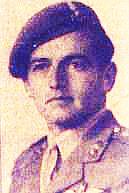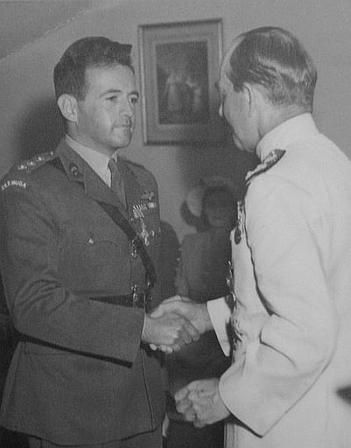

Richard Gorham began his military career in 1938, enlisting in the Bermuda Volunteer Engineers (BVE). Mobilized on the 22nd August, 1939, he was at first posted to the HM Dockyard as the Yeoman's assistant signaller. After a course in visual signalling, he was soon moved to the 'Topo Radio Station', which liased with the Harbour Radio and and the Examination Battery at Saint David's Head.
The BVE, in addition to providing wireless and other signals elements to the various naval and military units which made up the island's garrison, furnished the searchlights and crews installed at the coastal artillery batteries. Richard Gorham, consequently, worked as an integral part of the artillery defences.
Promoted from Corporal to 2 Lieutenant, he took advantage of an Army Council stipulation that allowed any officer to attend any course he chose to volunteer, crossing the Atlantic to train as a pilot.
At that time, the Royal Air Force was responsible for all military aviation*. This included the Air Observation Post squadrons - which operated light planes over the battlefield, from which the pilots might observe, and direct the fire of the Royal Artillery's (the Army's) field guns.
The RAF had had difficulties, however, in training its aviators to direct the guns - to 'shoot' - so it had been decided to train Royal Artillery officers, instead, to fly, though they still served on the strength of RAF AOP squadrons.
Applying for this training, Gorham crossed the Atlantic in the company of another soldier (Michael Gregg, who would also win the DFC serving as a Royal Artilery AOP pilot). They joined the Royal Artilley at the holding station in Woolwich, from where Gorham was posted to RAF Hatfield for his basic flying training. This included instruction in signals and Morse code, in fact. Being already proficient, Gorham was actually called upon to teach these classes to his fellow students.
Gaining his wings, Gorham was next sent to the Signals Flying Training School at Old Sarum for advanced training simulating combat flying conditions. Comnpleting this, he was posted to 654 Squadron in Yorkshire where he trained in cross-Channel flight and in operating from aircraft carriers.
His training complete, Gorham was sent first to North Africa, then joining 655 Squadron in Italy. He served with this unit, flying over the battlrfields of Anzio and Monte Cassino. At Cassino, he was to play a pivotal role in the final, decisive part of that long battle.
While patroling ahead of the British Army's right flank, he spotted a large number of half-tracked vehicles advancing upon the British positions. As the only Allied forces to use this type of vehicle were the American services, and as the nearest American forces were twenty miles away, he recognized them as German. In fact, it would prove to be an entire German armoured division moving to counter-attack.
Calling up for control of all 2,000 Allied artillery pieces in the area, he began directing their fire upon the German division. The artillery bombardment would continue all day. Gorham spent 2 1/2 hours overhead, taking turns with other pilots in directing the fire. The RAF tactical squadrons joined in, too, dive-bombing the German vehicles throughout the day.
The effect of this action was to destroy the Germans' ability to maintain any useful defence of Cassino, and the British forces broke through four days later.
Subsequently, Gorham would earn the award of the Distinguished Flying Cross (DFC) through his dogged hunt for a German Self Propelled Gun (SPG) that had been shelling British positions. The gun was very well camouflaged, and the Germans ceased firing every time an aeroplane appeared, forcing Gorham to fly ever lower, at increasing risk from ground fire, during succesive flights, scouring the countryside for the troublesome gun. He only realized he was on top of it when he suddenly found himself in a cloud of anti-aircraft fire. After a few nerve-wracking minutes, he suceeded in escaping this unscathed. Returning to his airstrip to refuel, he imediately set back out, directing fire to destroy the German gun.
Although an Army officer, Gorham was serving on the strength of an RAF squadron, hence he was awarded the RAF's DFC, rather than the Army's Military Cross.
At the War's end, Gorham was a Captain, in command of his own flight. He returned to the Island, and to a succesful business and Parliamentary career. He continued his military career, also, serving in the Bermuda Volunteer Rifle Corps ( re-titled the Bermuda Rifles after the War. The BVE, having been out-evolved by modern technology and the construction of the US air bases, was disbanded.) He reached the rank of Colonel upon his retirement from the part-time unit.
*The Royal Air Force had been created in 1918, during the Great War, by merging the Army's Royal Flying Corps with the Royal Navy's Royal Naval Air Service to create an independent Service. The RAF maintained responsibility for all military and naval aviation -together with its own strategic air element- until 1939, when the Royal Navy resumed the responsibility for equipping and manning the Fleet Air Arm.
The Army's only air units during the war were the Parachute Regiment, the Special Air Service Regiment, the Glider Pilot's Regiment, the Air Landing (infantry) regiments, and various sub-units given an air-bourne tasking. From 1942, these were all collected together under the umbrella organization of the Army Air Corps (AAC). Today, only the Parachute and SAS regiments, and atached support elements, remain, but the Army Air Corps encompasses only the Army's helicopter squadrons.
This entry is based largely on the text of an article by Peter Bonete, published in the Mid Ocean News, 11 March, 1972.